The Ramblings of a Bush Philosopher
Photo gallery: Indonesia
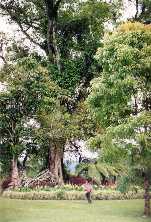 It's a fascinating and very diverse country, held together - for the
present - by a government in which corruption is the norm and by a
military that is not reluctant to use brutality against its own
people.
The peoples of different regions have different natures,
different artistic abilities, different religions, different
attitudes to outsiders.
Most of Indonesia is oppressively hot for Caucasians; it can
be frustrating, the people annoying, sometimes seemingly only
interested in your money (and they can be
very friendly and obliging); but if you do
visit, you will remember it.
It's a fascinating and very diverse country, held together - for the
present - by a government in which corruption is the norm and by a
military that is not reluctant to use brutality against its own
people.
The peoples of different regions have different natures,
different artistic abilities, different religions, different
attitudes to outsiders.
Most of Indonesia is oppressively hot for Caucasians; it can
be frustrating, the people annoying, sometimes seemingly only
interested in your money (and they can be
very friendly and obliging); but if you do
visit, you will remember it.
These photos and reminiscences are from a visit in about 1994.
Click on the pictures that have a bright border to see them full size.
Then use the 'back' button to return to this page.
Photographs of other areas or subjects are available via the home page.
Indonesia is a land of volcanoes!
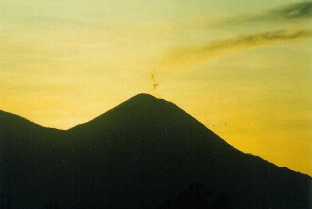 Wherever you are in Indonesia, it's quite likely that you can see a
volcano. This one could be seen from any place with
a relatively open horizon around the city of Milang (eastern Java).
Wherever you are in Indonesia, it's quite likely that you can see a
volcano. This one could be seen from any place with
a relatively open horizon around the city of Milang (eastern Java).
The Indonesian people grow up with smoking volcanoes in the distance;
it's a little difficult for an Australian to fully appreciate.
|
Bali
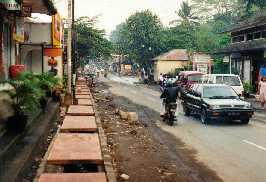 A street scene in Ubud.
A street scene in Ubud.
Ubud is in the interior of Bali, and is
well known as a centre for the arts.
Work was plainly under way on the footpaths, but no one seemed to
be in any hurry to get the job finished.
 Monkey Forest and Temple
Monkey Forest and Temple
Within walking distance of Ubud is the Monkey Forest. The monkeys
are cute, not much afraid of people, but bite if it suites them.
One stole my pocket diary and nipped me when I took it back.
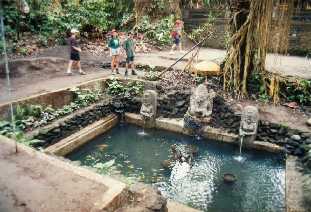 In the Monkey Forest is a temple with a pool.
In the Monkey Forest is a temple with a pool.
The shade and the
flowing water give some relief from the normal humid heat of
lowland Indonesia.
I had a problem with the focus on my camera. This photo is not
clear enough to allow an enlargement.
 Elephant Cave Temple
Elephant Cave Temple
This temple was lost for many years.
That's hard to imagine in an
island the size of Bali, inhabited by two million people. How would
it be possible to loose something the size of a temple? Perhaps it
became overgrown with dense vegetation.
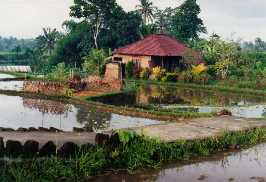 House among rice paddies
House among rice paddies
Early mornings are pleasantly
cool, and the local people seem more friendly then; perhaps it's
just that the people who work in the tourist industry are not yet out
and about. Perhaps that's unkind?
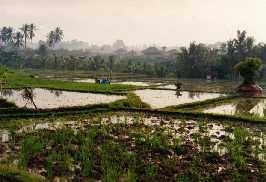 Another early morning view over the rice paddies of Ubud.
Another early morning view over the rice paddies of Ubud.
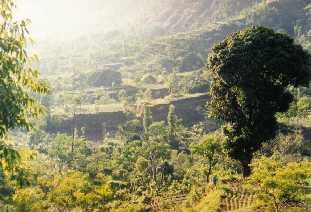 On the slopes of the giant Batur caldera
On the slopes of the giant Batur caldera
Some of the trees bear fruit. One wonders if all the trees that can
be seen here have some economic purpose, whether every one was
planted, or do some grow wild?
The time of day was mid-morning I think.
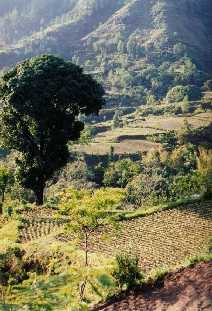 Similar to the last photograph, but this one better shows the
cultivation in the foreground.
Similar to the last photograph, but this one better shows the
cultivation in the foreground.
How much work must have gone into leveling those fields!
The altitude of the Lake Batur area gives it a more pleasant
climate than lowland Bali; while certainly not cold, it was possible
to enjoy climbing a mountain.
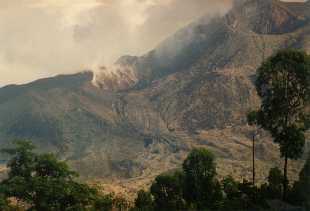 Mt Batur
Mt Batur
This volcano is roughly in the centre of Batur caldera. The
active crater on the side of the mountain was very impressive up close.
There was a continuous roar of escaping steam, punctuated by a
louder and more ominous rumble periodically. One could feel the
ground vibrating, and there was the acrid smell of sulfur dioxide
in the air; strong enough at times to make one wonder whether
breathing might become difficult if the activity picked up.
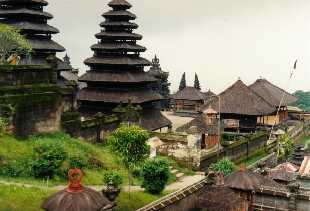 Besakih Temple
Besakih Temple
The most important Hindu temple on Bali is Besakih on the lower
slopes of Mt Agung.
However, while it is big, spread over a large area, and special to
the Balinese, I found it less pleasant to visit than some of the
smaller, less formal temples.
 Hindu ceremonies in Bali, in my experience, are always very colourful.
We happened to see this one in Besakih.
Hindu ceremonies in Bali, in my experience, are always very colourful.
We happened to see this one in Besakih.
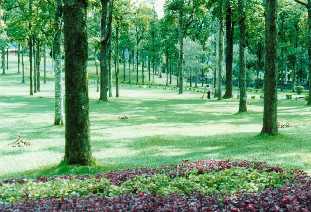 Botanical garden
Botanical garden
The botanical garden at Candikuning in the mountains was a great
escape from the numerous people that were to be encountered most
places.
Perhaps the locals come to the botanical garden on weekends and
public holidays, but they weren't to be seen while we were there.
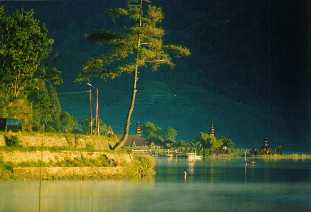 Seen on an early morning walk beside Lake Bratan in the highlands
of Bali.
Seen on an early morning walk beside Lake Bratan in the highlands
of Bali.
I remembered this area from my first trip to Bali in 1973, but it
was very difficult to place individual features. There had been
many changes in twenty-one years.
 Gunung (Mt) Agung, swathed in clouds, seen from Lake Bratan.
Gunung (Mt) Agung, swathed in clouds, seen from Lake Bratan.
This highest mountain on Bali is very important to the majority Hindus.
Its last serious eruption was in March 1963.
JAVA
The Dieng Plateau
 The Dieng Plateau is one place in Java where one can escape the heat.
There can, however, be a cost: the very unpleasant loud Islamic
calls-to-prayer that come five times a day, starting in early
morning and finishing in the evening.
The Dieng Plateau is one place in Java where one can escape the heat.
There can, however, be a cost: the very unpleasant loud Islamic
calls-to-prayer that come five times a day, starting in early
morning and finishing in the evening.
I believe that Islam uses the human voice for the call to prayer
because Mohammed didn't like the sound of church bells. I wonder
whether he would like the modern-day recorded and amplified calls
any more than he liked church bells?
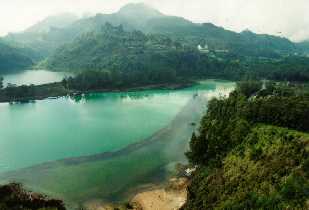 The Dieng Plateau was one of my favourite places in Indonesia. The
lower temperatures were a large factor in this, but it was also
beautiful and fascinating. This lake, seen on an early morning walk,
was sulfurous from the almost ubiquitous volcanic activity.
The Dieng Plateau was one of my favourite places in Indonesia. The
lower temperatures were a large factor in this, but it was also
beautiful and fascinating. This lake, seen on an early morning walk,
was sulfurous from the almost ubiquitous volcanic activity.
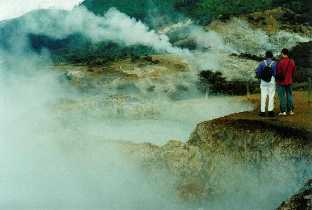 Boiling-mud pools and fume vents were scattered about on the plateau.
Boiling-mud pools and fume vents were scattered about on the plateau.
Baluran National Park
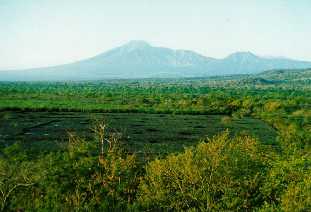 Baluran National Park in north-eastern Java is out-of-the-way and not
visited by many tourists. Accommodation is available, but no meals -
take your own. Arrange for some-one to pick you up before you go because
you'll probably find no-one at Baluran who speaks any English.
Baluran National Park in north-eastern Java is out-of-the-way and not
visited by many tourists. Accommodation is available, but no meals -
take your own. Arrange for some-one to pick you up before you go because
you'll probably find no-one at Baluran who speaks any English.
It's worth a visit, native vegetation (and some pretty bad infestations
of introduced Acacias), a few species of native animals, and some
interesting walks. But it is very much 'do it yourself'.
 These wild (feral?) pigs came in close to the accommodation block to
pick up any scraps that they could find.
These wild (feral?) pigs came in close to the accommodation block to
pick up any scraps that they could find.
Home
Top
 Wherever you are in Indonesia, it's quite likely that you can see a
volcano. This one could be seen from any place with
a relatively open horizon around the city of Milang (eastern Java).
Wherever you are in Indonesia, it's quite likely that you can see a
volcano. This one could be seen from any place with
a relatively open horizon around the city of Milang (eastern Java).
 It's a fascinating and very diverse country, held together - for the
present - by a government in which corruption is the norm and by a
military that is not reluctant to use brutality against its own
people.
The peoples of different regions have different natures,
different artistic abilities, different religions, different
attitudes to outsiders.
Most of Indonesia is oppressively hot for Caucasians; it can
be frustrating, the people annoying, sometimes seemingly only
interested in your money (and they can be
very friendly and obliging); but if you do
visit, you will remember it.
It's a fascinating and very diverse country, held together - for the
present - by a government in which corruption is the norm and by a
military that is not reluctant to use brutality against its own
people.
The peoples of different regions have different natures,
different artistic abilities, different religions, different
attitudes to outsiders.
Most of Indonesia is oppressively hot for Caucasians; it can
be frustrating, the people annoying, sometimes seemingly only
interested in your money (and they can be
very friendly and obliging); but if you do
visit, you will remember it.
 A street scene in Ubud.
A street scene in Ubud.

 In the Monkey Forest is a temple with a pool.
In the Monkey Forest is a temple with a pool.
 Elephant Cave Temple
Elephant Cave Temple
 House among rice paddies
House among rice paddies

 On the slopes of the giant Batur caldera
On the slopes of the giant Batur caldera

 Mt Batur
Mt Batur

 Hindu ceremonies in Bali, in my experience, are always very colourful.
We happened to see this one in Besakih.
Hindu ceremonies in Bali, in my experience, are always very colourful.
We happened to see this one in Besakih.
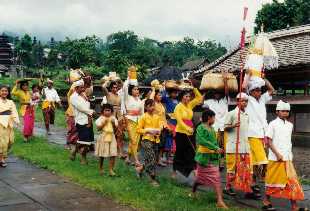
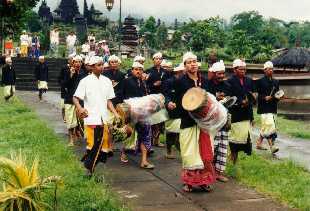
 Botanical garden
Botanical garden
 Seen on an early morning walk beside Lake Bratan in the highlands
of Bali.
Seen on an early morning walk beside Lake Bratan in the highlands
of Bali.

 The Dieng Plateau is one place in Java where one can escape the heat.
There can, however, be a cost: the very unpleasant loud Islamic
calls-to-prayer that come five times a day, starting in early
morning and finishing in the evening.
The Dieng Plateau is one place in Java where one can escape the heat.
There can, however, be a cost: the very unpleasant loud Islamic
calls-to-prayer that come five times a day, starting in early
morning and finishing in the evening.
 The Dieng Plateau was one of my favourite places in Indonesia. The
lower temperatures were a large factor in this, but it was also
beautiful and fascinating. This lake, seen on an early morning walk,
was sulfurous from the almost ubiquitous volcanic activity.
The Dieng Plateau was one of my favourite places in Indonesia. The
lower temperatures were a large factor in this, but it was also
beautiful and fascinating. This lake, seen on an early morning walk,
was sulfurous from the almost ubiquitous volcanic activity.
 Boiling-mud pools and fume vents were scattered about on the plateau.
Boiling-mud pools and fume vents were scattered about on the plateau.
 Baluran National Park in north-eastern Java is out-of-the-way and not
visited by many tourists. Accommodation is available, but no meals -
take your own. Arrange for some-one to pick you up before you go because
you'll probably find no-one at Baluran who speaks any English.
Baluran National Park in north-eastern Java is out-of-the-way and not
visited by many tourists. Accommodation is available, but no meals -
take your own. Arrange for some-one to pick you up before you go because
you'll probably find no-one at Baluran who speaks any English.
